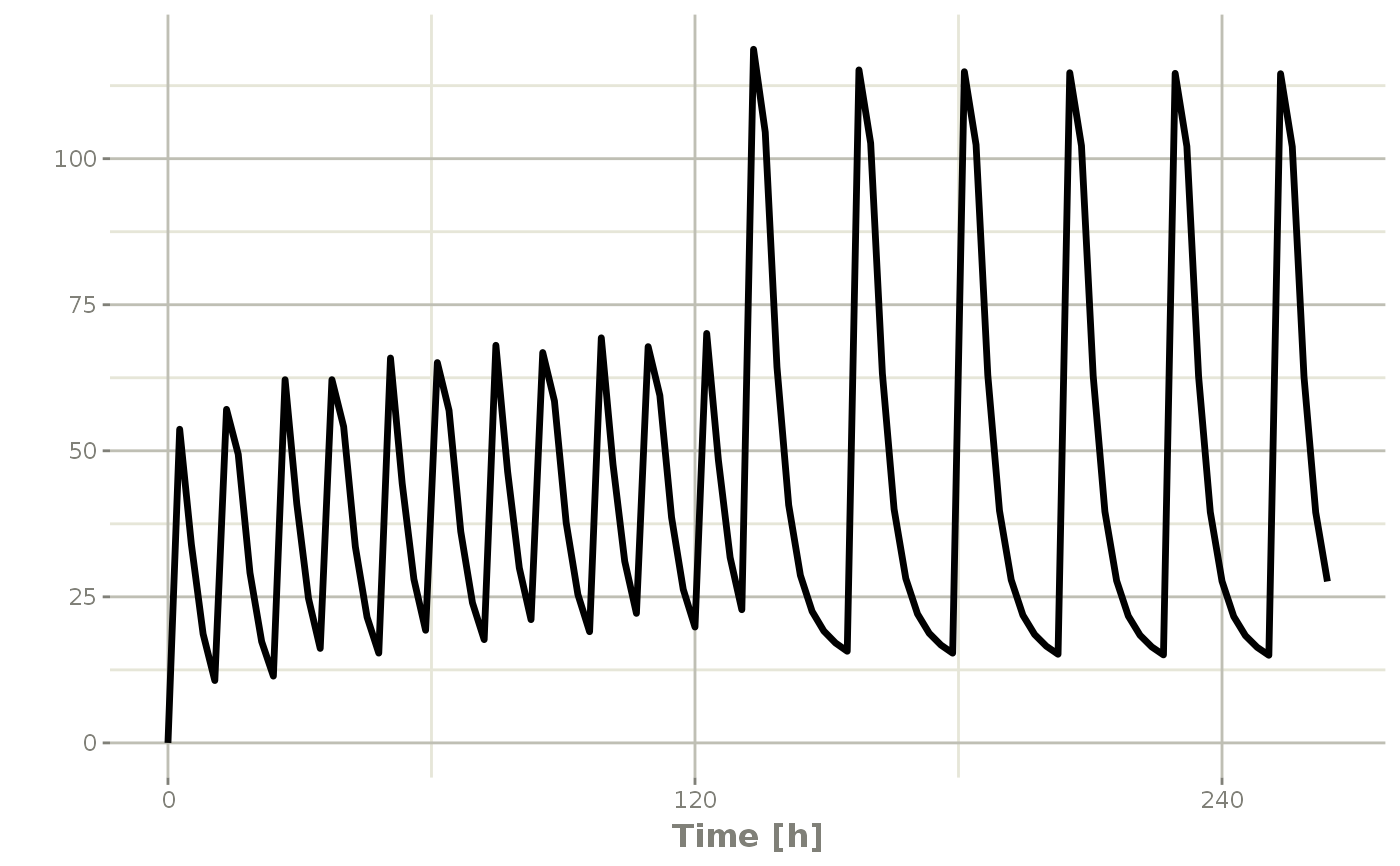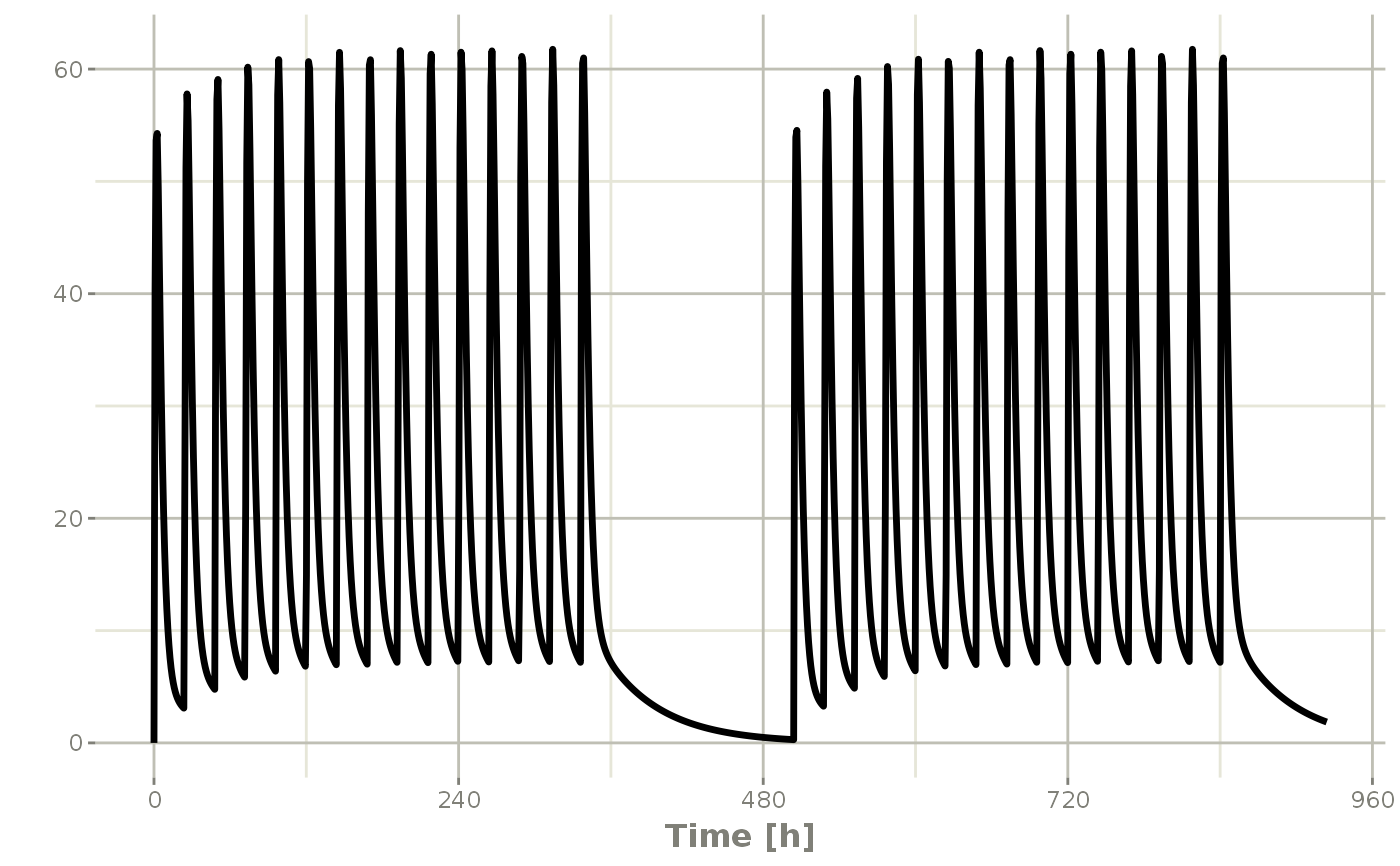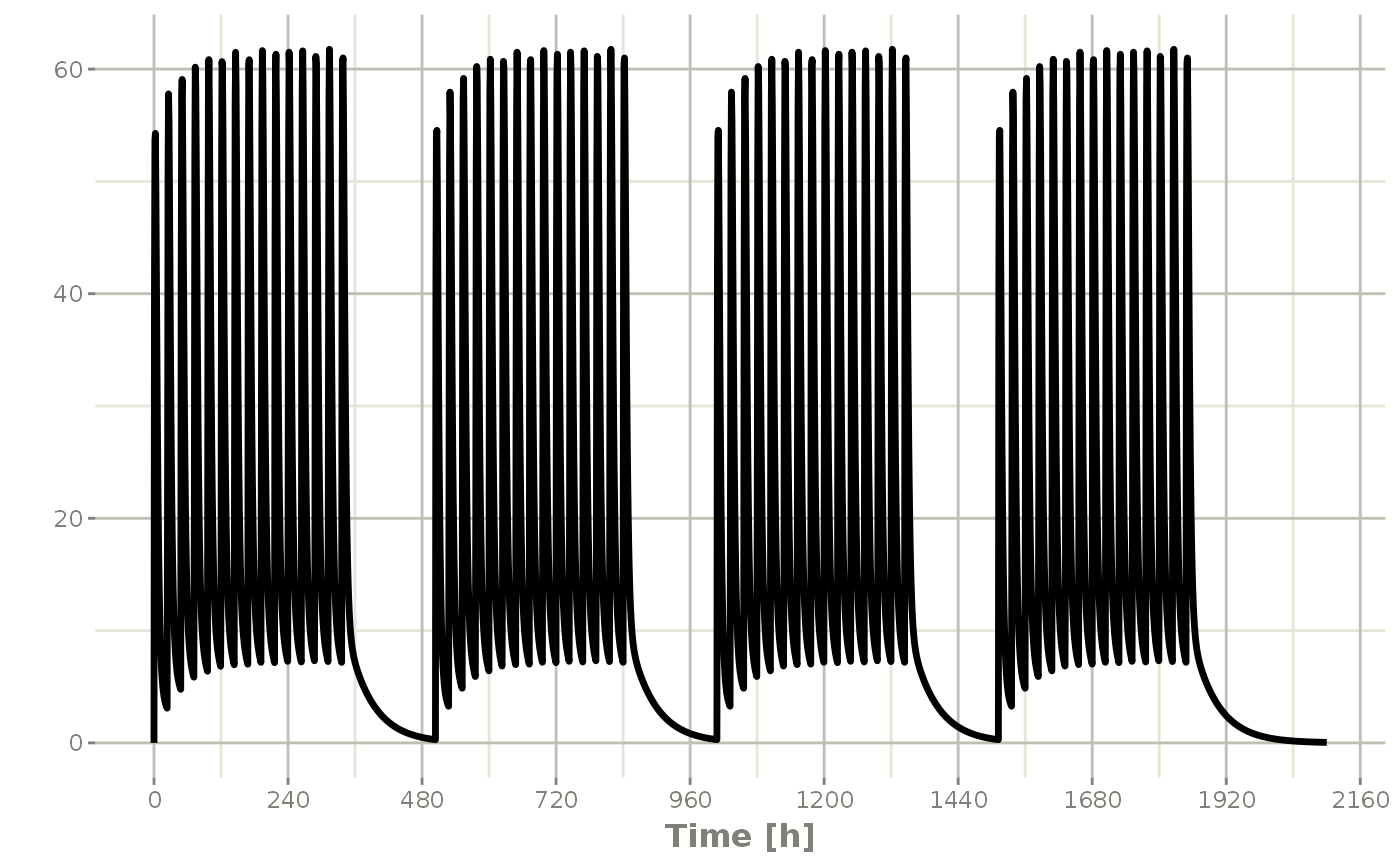This combines a sequence of event tables.
etSeq(..., samples = c("clear", "use"), waitII = c("smart", "+ii"), ii = 24)
# S3 method for rxEt
seq(...)Arguments
| ... | The event tables and optionally time between event tables, called waiting times in this help document. |
|---|---|
| samples | How to handle samples when repeating an event table. The options are:
|
| waitII | This determines how waiting times between events are handled. The options are:
|
| ii | If there was no inter-dose intervals found in the event
table, assume that the interdose interval is given by this
|
Value
An event table
Details
This sequences all the event tables in added in the
argument list .... By default when combining the event
tables the offset is at least by the last inter-dose interval in
the prior event table (or ii). If you separate any of the
event tables by a number, the event tables will be separated at
least the wait time defined by that number or the last inter-dose
interval.
References
Wang W, Hallow K, James D (2015). "A Tutorial on RxODE: Simulating Differential Equation Pharmacometric Models in R." CPT: Pharmacometrics \& Systems Pharmacology, 5(1), 3-10. ISSN 2163-8306, <URL: https://www.ncbi.nlm.nih.gov/pmc/articles/PMC4728294/>.
See also
Author
Matthew L Fidler, Wenping Wang
Examples
# \donttest{
library(RxODE)
library(units)
## Model from RxODE tutorial
mod1 <-RxODE({
KA=2.94E-01;
CL=1.86E+01;
V2=4.02E+01;
Q=1.05E+01;
V3=2.97E+02;
Kin=1;
Kout=1;
EC50=200;
C2 = centr/V2;
C3 = peri/V3;
d/dt(depot) =-KA*depot;
d/dt(centr) = KA*depot - CL*C2 - Q*C2 + Q*C3;
d/dt(peri) = Q*C2 - Q*C3;
d/dt(eff) = Kin - Kout*(1-C2/(EC50+C2))*eff;
});
#>
## These are making the more complex regimens of the RxODE tutorial
## bid for 5 days
bid <- et(timeUnits="hr") %>%
et(amt=10000,ii=12,until=set_units(5, "days"))
## qd for 5 days
qd <- et(timeUnits="hr") %>%
et(amt=20000,ii=24,until=set_units(5, "days"))
## bid for 5 days followed by qd for 5 days
et <- seq(bid,qd) %>% et(seq(0,11*24,length.out=100));
bidQd <- rxSolve(mod1, et)
plot(bidQd, C2)
 ## Now Infusion for 5 days followed by oral for 5 days
## note you can dose to a named compartment instead of using the compartment number
infusion <- et(timeUnits = "hr") %>%
et(amt=10000, rate=5000, ii=24, until=set_units(5, "days"), cmt="centr")
qd <- et(timeUnits = "hr") %>% et(amt=10000, ii=24, until=set_units(5, "days"), cmt="depot")
et <- seq(infusion,qd)
infusionQd <- rxSolve(mod1, et)
plot(infusionQd, C2)
## Now Infusion for 5 days followed by oral for 5 days
## note you can dose to a named compartment instead of using the compartment number
infusion <- et(timeUnits = "hr") %>%
et(amt=10000, rate=5000, ii=24, until=set_units(5, "days"), cmt="centr")
qd <- et(timeUnits = "hr") %>% et(amt=10000, ii=24, until=set_units(5, "days"), cmt="depot")
et <- seq(infusion,qd)
infusionQd <- rxSolve(mod1, et)
plot(infusionQd, C2)
 ## 2wk-on, 1wk-off
qd <- et(timeUnits = "hr") %>% et(amt=10000, ii=24, until=set_units(2, "weeks"), cmt="depot")
et <- seq(qd, set_units(1,"weeks"), qd) %>%
add.sampling(set_units(seq(0, 5.5,by=0.005),weeks))
wkOnOff <- rxSolve(mod1, et)
plot(wkOnOff, C2)
## 2wk-on, 1wk-off
qd <- et(timeUnits = "hr") %>% et(amt=10000, ii=24, until=set_units(2, "weeks"), cmt="depot")
et <- seq(qd, set_units(1,"weeks"), qd) %>%
add.sampling(set_units(seq(0, 5.5,by=0.005),weeks))
wkOnOff <- rxSolve(mod1, et)
plot(wkOnOff, C2)
 ## You can also repeat the cycle easily with the rep function
qd <-et(timeUnits = "hr") %>% et(amt=10000, ii=24, until=set_units(2, "weeks"), cmt="depot")
et <- etRep(qd, times=4, wait=set_units(1,"weeks")) %>%
add.sampling(set_units(seq(0, 12.5,by=0.005),weeks))
repCycle4 <- rxSolve(mod1, et)
plot(repCycle4, C2)
## You can also repeat the cycle easily with the rep function
qd <-et(timeUnits = "hr") %>% et(amt=10000, ii=24, until=set_units(2, "weeks"), cmt="depot")
et <- etRep(qd, times=4, wait=set_units(1,"weeks")) %>%
add.sampling(set_units(seq(0, 12.5,by=0.005),weeks))
repCycle4 <- rxSolve(mod1, et)
plot(repCycle4, C2)
 # }
# }